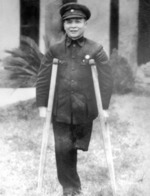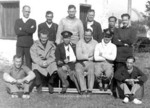Chan Chak
| Surname | Chan |
| Given Name | Chak |
| Born | 2 Apr 1894 |
| Died | 31 Aug 1949 |
| Country | China |
| Category | Military-Sea |
| Gender | Male |
Contributor: C. Peter Chen
ww2dbaseChan Chak (Cantonese: Chan Chak; Mandarin Pinyin: Chen Ce), courtesy name Choushuo, unofficial English name "Andrew", was born in Wenchang, Guangdong Province (now Hainan Special Administrative Region), China. His family moved to Singapore when he was three years old, and returned to China at the age of eight. Upon completion of elementary school, he enrolled in the Guangdong Navy Academy in the city of Guangzhou; it was during this time he joined the Tongmenghui which sought to overthrow the Qing Dynasty. After the fall of Qing and the establishment of the Republic of China, he participated in the failed opposition against Yuan Shikai, and fled to Hong Kong. In 1917, at the start of the Constitutional Protection Movement, he supported Sun Yatsen. In Jun 1922, he coordinated in the extraction of Sun when Sun clashed with political rival Chen Yuming. In 1923, he was made the commanding officer of the Guangdong Fleet. After the 1926-1928 Northern Expedition, the Guangdong Fleet was renamed the 4th Fleet, and he remained its commanding officer. In 1930, he based his fleet at northern Hainan. In 1932, he clashed with General Chen Jizhen of Guangdong, resulting in Chen sinking one of Chan's ships by air; Chan was forced from his position by the central government and was transferred abroad to help dodge political consequences. After his return, he was elected to the Central Executive Committee of the Nationalist Party, assisting in naval planning against a possible full scale war with Japan. In 1936, Chen Jizhen announced his opposition to Nationalist leader Chiang Kaishek, but Chen's military leaders were unexpectedly loyal to Chiang; Chen's naval forces mutinied and went to Chan.
ww2dbaseWhen WW2 began in China in 1937, Chan was named the commanding officer of defenses along the Guangdong coast, with headquarters in Humen, Guangdong Province. In Oct 1938, when Japanese troops advanced on Guangzhou by sea, the Japanese attempted to bribe retired former mayor Li Fulin, intending on using Li to convince Chan to put down arms. Chan and Li then orchestrated a false agreement, and thus able to kill or wound several hundred Japanese troops as they landed unsuspectingly at Humen. Before he withdrew his headquarters from Humen, he was wounded during a Japanese barrage, which would later lead to the amputation of his left leg. In 1939, Rear Admiral Chan was secretly assigned to Hong Kong to head the Nationalist Party's operations in Hong Kong and Macau, under the disguise as a stockbroker, as the United Kingdom and Japan had not yet engaged in war. In this role, he helped organize underground resistance activities within China, and planned joint defense plans between Chinese and British forces should Japan invade Hong Kong. He also maintained a network of informants within organized crime groups, identifying possible Japanese sympathizers and anti-British nationalists. Japanese forces attacked Hong Kong in Dec 1942. Hours before the British surrender on 25 Dec 1942, Governor Sir Mark Aitchison Young informed Chan of the intended surrender announcement, and gave Chan the command of a small Royal Navy contingent. The contingent consisted of 10 naval and intelligence officers, several sailors, several Marines, and a number of enlisted men, and 5 motor torpedo boats; several Danish and Chinese intelligence officers were also attached to this contingent sized at 68 men. Young asked Chan to assist the small fleet in escaping capture, and Chan readily agreed. Chan and his small entourage boarded the motor launch Cornflower II at Aberdeen Harbour to make rendezvous with the British motor torpedo boats. En route, the launch was detected and sunk by a Japanese warship. Chan was wounded in the wrist and found himself in the water; despite not being able to swim with one wounded arm and one artificial leg, he gave his life jacket to his bodyguard, who did not know how to swim. He was eventually saved by his aide-de-camp Lieutenant Commander Henry Hsu. Aware of the attack on Chan's party, the five British motor torpedo boats approached and saved Chan and his men south of Ap Lei Chau (aka Aberdeen Island). The boats then entered Mirs Bay to the northeast of Hong Kong, making landfall south of Huizhou. He then led the group of Chinese and British men on a four-day journey, on foot, to Huizhou, which was still under Chinese control. From there, Chan led his group of Chinese and British men westward through Yunnan Province, where they were met with British liaison officers who would ultimately arrange for their return to Britain via Burma and India. King George VI would later make Chan a honorary Knight Commander of the Order of the British Empire for aiding in the escape of these Royal Navy personnel. In 1943, he converted to Catholicism. He served as a military adviser to the Nationalist Party during the remaining years of WW2.
ww2dbaseAfter WW2, Chan was the mayor of Guangzhou between late 1945 and Jun 1946. In Apr 1947, he was made a senior adviser to the Chinese central government. He passed away from a bleeding stomach ulcer in Aug 1949; rumors had it that he committed suicide by ingesting sleeping pills after losing large sums of money during a failed gold speculation scheme.
ww2dbaseSource: Wikipedia
Last Major Revision: Mar 2020
Photographs
 |  |
Chan Chak Timeline
| 2 Apr 1894 | Chan Chak was born in Wenchang, Guangdong Province (now Hainan), Qing Dynasty China. |
| 25 Dec 1941 | Chinese Rear Admiral Chan Chak led a group consisted mostly of British military servicemen out of Hong Kong using five Royal Navy motor torpedo boats. They made landfall on the Guangdong Province, China coast, where Chan would lead them toward the city of Huizhou on foot. |
| 29 Dec 1941 | Chinese Rear Admiral Chan Chak arrived in Huizhou, Guangdong Province, China with a group of British officers and men who had escaped from Hong Kong four days prior. |
| 18 Apr 1947 | Chan Chak was made a senior adviser to the Chinese central government. |
| 31 Aug 1949 | Chan Chak passed away from a bleeding stomach ulcer in Guangzhou, Guangdong Province, China. |
Please consider supporting us on Patreon. Even $1 per month will go a long way! Thank you. Please help us spread the word: Stay updated with WW2DB: |
Visitor Submitted Comments
All visitor submitted comments are opinions of those making the submissions and do not reflect views of WW2DB.

» Guangdong Operation
» Battle of Hong Kong
- » 1,182 biographies
- » 337 events
- » 45,119 timeline entries
- » 1,248 ships
- » 350 aircraft models
- » 207 vehicle models
- » 376 weapon models
- » 123 historical documents
- » 261 facilities
- » 470 book reviews
- » 28,411 photos
- » 365 maps
Thomas Dodd, late 1945
1 Oct 2022 04:16:31 AM
Where can I obtain a copy of the portrait of Chan Chak for use in a display?